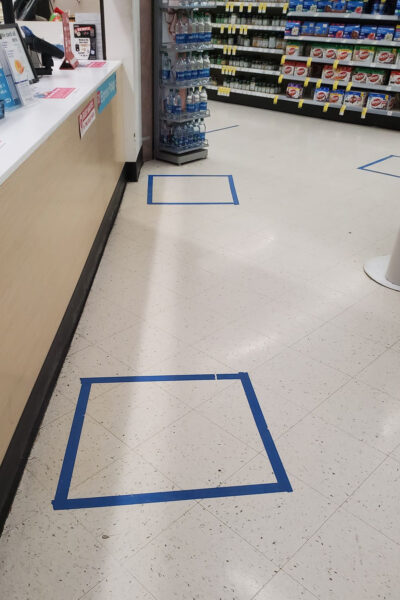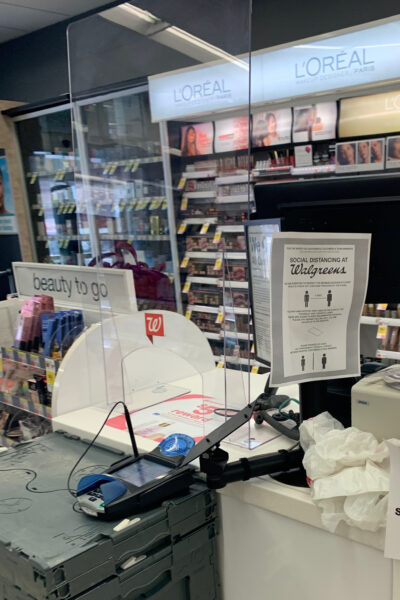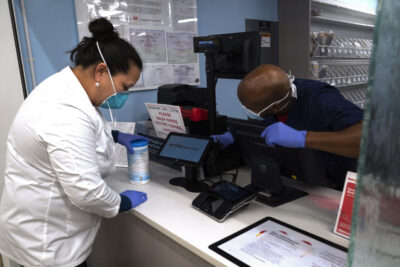ProPublica is a nonprofit newsroom that investigates abuses of power. Sign up to receive our biggest stories as soon as they’re published.
At his home in the Bronx, where he lies in bed with a fever, Jose Peralta keeps replaying the scene in his head. It was Monday, March 16, the start of an unusually hectic week at a Walgreens in the Chelsea neighborhood of New York City. Peralta, a senior pharmacy technician, was on his way to take a break when he noticed a familiar customer waiting in line to pick up medication.
“I thought, Gee it would be nice to help this guy,” Peralta said. “We’ve all been trying to minimize exposure and make sure that people don’t have to spend too long in the store.”
Returning to the counter, Peralta chatted briefly with the customer only a few feet away. Even though he was working at the center of the nation’s coronavirus outbreak, Walgreens hadn’t given him gloves or a mask, he said.
A few days later, during routine calls to customers about medication ready for pickup, Peralta learned that the customer whom he had helped had tested positive for COVID-19. Peralta notified his manager that he may have been exposed to the virus. The manager checked with headquarters and told him to keep working, Peralta said.
Toward the end of March, Peralta and two colleagues started to come down with telltale symptoms: A loss of smell and taste. Fatigue. Body aches. He realized that he might be laid up for weeks — far longer than his sick pay would last.
Pharmacy workers like Peralta are on the front lines of the nation’s response to the pandemic, providing medications and advice to an ever growing number of Americans. Yet like other businesses deemed essential in the coronavirus outbreak, Walgreens and CVS have been accused by employees of failing to protect their health or provide adequate sick pay. The nation’s two biggest retail pharmacy chains are among at least a dozen large companies, including groceries and delivery services, whose employees have circulated petitions seeking stronger safety measures.
Twenty-five Walgreens and CVS employees told ProPublica that they’re coping with more customers, prescriptions and payments than ever before without a corresponding increase in staffing or safety measures. (Nearly all of the workers requested anonymity because they were not authorized to speak publicly and feared losing their jobs.) Though precautions vary from one store to the next, Peralta and employees at several other Walgreens stores said that throughout March, they did not receive masks, gloves, cleaning supplies or plexiglass shields to separate them from customers.
Without sufficient safeguards, pharmacies could become vectors for spreading the coronavirus within communities, according to Denis Nash, a professor of epidemiology at the CUNY School of Public Health. “This is not a hospital setting per se, but it is a busy place where sick people may be going at a time when transmission of SARS-CoV-2 is high,” he said.
After Peralta reported that he had been exposed to the virus, the Chelsea store on 8th Avenue was not closed for disinfecting, he said. Nor did Walgreens alert customers or workers picking up shifts for self-quarantined colleagues that several workers had fallen sick, Peralta said. In at least seven Walgreens including Peralta’s, workers who have been exposed to the virus said that the company has not shut down the stores for cleaning and has not given full sick pay to workers quarantined with presumed positive cases.
“They’re staying open, they’re not being sanitized and no one there is being warned that this is a problem,” Peralta said. “People are going to work sick with this virus because they can’t afford to stay home.”
Both Walgreens and CVS said they are following all government guidelines. “Walgreens champions the health and well-being of every community in America, playing a critical role in providing patients and customers access to the care, products and services they need,” said Molly Sheehan, a Walgreens spokeswoman. She added, “We have instituted extensive safety measures for our employees and in our stores.”
Asked about Peralta’s experience, Sheehan acknowledged that “there was a case of a known exposure” at the Chelsea store. “This matter was considered low risk and we followed guidance from” the Centers for Disease Control and Prevention and “our established protocols,” she said. She declined further comment on the incident, citing the privacy of employee health.
CVS spokesman Mike DeAngelis said: “Pharmacies are a critical resource for communities across the country, and we’ll continue to be here for customers and patients in these trying times. We’re constantly working to increase availability of supplies and update protocols to ensure our stores are safe for employees and customers alike.”
As hospitals have been overwhelmed with patients, pharmacies have become the first stop for people feeling unwell. Pharmacists said that once the CDC and others advised Americans to stock up on medication, they were flooded with double, sometimes triple, as many prescriptions to fill. In March, employees said, they were coming face to face with hundreds more customers. There was more talking, more sneezing and more coughing.
Almost 120,000 people have signed two petitions urging pharmacies to rely on drive through service wherever possible. One petition directed at CVS asks it to close the front of the store, where goods are sold over the counter, and to fill prescriptions through curbside pickup, drive-thru and home delivery. These recommendations have been echoed by the CDC.
Both companies say they have encouraged drive-thru and waived home delivery charges in an effort to slow down foot traffic. As of last week, however, Walgreens continued to email customers coupons and text push notifications — “Stop in, We’re nearby!” — enticing them to come into the store. CVS has extended the time for customers to redeem its coupons. In an April 1 letter to the Occupational Safety and Health Administration, the American Pharmacists Association noted that “implementation is highly variable for social distancing mechanisms such as home delivery, curbside or drive-through service or implementing barrier windows or directional signage to minimize contact with and among patients.”

Walgreens and CVS said they have instituted enhanced cleaning measures and limited store hours. In late March, a weekly cleaning service arrived at many Walgreens locations, while CVS has shipped a box of Lysol canisters to stores. CVS and Walgreens are hiring thousands of new employees and have recently supplied stores with tape, so employees can mark the appropriate distances between customers in line.
CVS said it requires cleaning of hard surfaces every hour, and of commonly handled items more frequently. But workers at numerous pharmacies said it was difficult to meet those expectations, especially without extra time, staff or resources. As a result, they said, their cleaning has been haphazard — limited to countertops and whatever materials each store has on hand. “We try to set timers, but it’s lucky if we do it twice a day,” a CVS technician in Montana said.
Because his store has run out of cleaning materials, a Walgreens pharmacist in Dayton, Ohio, has been encouraging his employees to wipe everything they’ve touched with hydrogen peroxide, despite the chemical’s corrosive effects on plastic. “I figure we can get new plastic and phones,” he said, “but we can’t get new people.” CVS and Walgreens said they are refreshing cleaning supplies as quickly as possible. Sheehan said Walgreens has increased its suppliers of hand sanitizer from two to more than 10.
Both Walgreens and CVS have promised to install plexiglass barriers at counters, a measure recommended by the American Pharmacists Association. OSHA similarly recommends that workplaces with a medium exposure risk, a category that includes high-volume retail settings, supply employees with face masks and plastic sneeze guards. But more than half of the pharmacists we spoke with — and more than 30 members of a Facebook group for pharmacists — said that their stores, with locations ranging from Washington to Florida, still don’t have these barriers. Others whose stores did get them said that the barriers provided insufficient coverage. “That’s not much protection,” one member posted on Facebook, next to a picture of a narrow standalone plane. Some members of the group reported that their plexiglass had already broken. In an email to ProPublica, CVS said that the barriers are due to arrive at all stores by the end of this week, and Walgreens said that it is installing them as quickly as possible.
“I am not intubating someone in the ICU, and I don’t need a full cover over my whole body,” a CVS pharmacist in Charlotte, North Carolina, told ProPublica. “But I do need something more than a 2-inch plexiglass barrier and a small bottle of hand sanitizer.”

Pharmacists, managers and technicians at both chains told ProPublica that they have improvised their own safety procedures, scrambling to buy basic equipment out of pocket. In Brooklyn, some Walgreens pharmacists said they have sewed masks and made their own hand sanitizer; others have hung shower curtains and table liners between themselves and customers. A CVS shift supervisor in rural Illinois, who couldn’t afford to buy her own gloves and whose store had run out of small sizes, said that her mom had shipped her a pair. The Walgreens pharmacist in Dayton went to the hardware store and built his own plastic cough shields for his employees, using freestanding frames with weights on the back.
“We’ve had to do a lot of things on our own and ask for forgiveness and not permission,” he said. “It’s a patient safety issue how they’ve left us hanging for so long.”
After Walmart announced a cash bonus policy, CVS and Walgreens said they would pay one-time bonuses for certain employees in late April. Both companies also said they have relaxed attendance rules and instituted paid leave policies for employees sick with the coronavirus. CVS said that it would offer two weeks of paid leave to any worker who tests positive or is told to quarantine by a doctor. Walgreens does not provide workers with quarantine pay unless they test positive. With a shortage of tests, the policy means that many Walgreens employees with the coronavirus may have little choice but to keep working, putting colleagues and the people who they interact with at risk, employees said.
“It’s problematic to require documented laboratory tests,” said Nash, the CUNY epidemiologist. “A physician diagnosis should be plenty for any employer to allow a person to stay home, not only until they themselves feel better but long enough so that they’re not going to spread it in a pharmacy to other workers and to clientele.”
A staff member will also be paid if “our clinical team determines a team member is a high risk and states the team member should quarantine without a positive test,” said Sheehan, the Walgreens spokeswoman. When notified of a confirmed COVID-19 case in a store, Walgreens notifies public health authorities, identifies and contacts individuals who may be at risk, and cleans and disinfects the location, which may include temporarily closing the store, Sheehan said.
An employee at a Walgreens in Ohio recently went into quarantine after her family, including her two small children, came down with a respiratory tract illness. She didn’t qualify for a coronavirus test, however, and had to use her paid time off. She’s most worried about what will happen to ailing co-workers who earn less and have less time off. “These are people living paycheck to paycheck,” she said. “They are underpaid for what they do and they don’t have the same PTO as pharmacists to accommodate a self-quarantine at home. At some point, someone will come into work sick and there’s nothing anyone can do about it.”
When a Walgreens in one Wisconsin town ran out of antibacterial wipes in early March, employees resorted to using masks and sanitizer they had brought themselves, a longtime employee there said. Soon four workers came down with COVID-19 symptoms, including the employee, who has an underlying condition, asthma, that increases risk. Unable to get tested, the employee provided the company with a doctor’s note advising quarantine, but it hasn’t been enough to keep getting a paycheck. “All of us are using our PTO to keep others safe,” said the employee, who is home with a cough and has a child with coronavirus symptoms. “When that runs out, we have to decide between not being able to pay bills and exposing other people.”
That’s a choice Peralta may face. A lifelong New Yorker, he has worked in the Chelsea store for a decade. Until getting sick, he commuted downtown to work each day on a still-packed D train. Until the CDC recommended masks last week, he said, workers were discouraged from wearing them in the store and, according to a policy shared with ProPublica, had only been allowed to give them to patients who were receiving immunizations. In step with the CDC’s evolving protocols, Walgreens announced on April 3 that it would provide “face covers” to its workers and CVS told employees this week that face masks would be mandatory, with full-time employees receiving two masks per week.
Even after he started feeling poorly, Peralta went to work on Monday, March 30, thinking that he was probably just tired and overworked. The next day, feeling even worse, he stayed home, where he’s been resting ever since, fatigued and with a fever. Because his symptoms are not dire, he has not been able to get tested, he said, and therefore doesn’t qualify for pay during his quarantine.
Though he’s hoping to use his time off to recover, Peralta has been busy calling the company’s various hotlines, asking Walgreens how it plans to take care of workers like him. He said he hasn’t gotten an answer yet.
“This is a health care crisis,” he said on Monday night, his voice laced with phlegm, “but Walgreens is behaving like it’s business as usual.”
Do you have information you’d like to share about working at a pharmacy? Or a tip on how your pharmacy is handling the pandemic? Please email [email protected].
Filed under:




